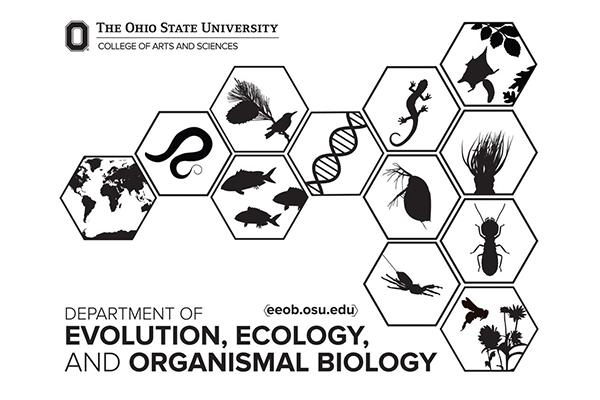EEOB Publications October 1 - October 31

Phylogeny and taxonomy of Haloclavidae (Verrill, 1899) with a redescription of the parasitic, burrowing sea anemone, Peachia chilensis Carlgren, 1931
Natalie Hamilton, Luciana C. Gusmão, Takato Izumi, Estefanía Rodríguez, Nicholas W. L. Yap, Marymegan Daly. 2022. PLOS One. https://doi.org/10.1371/journal.pone.0266283
Abstract
Haloclavidae Verrill, 1899 is a family of burrowing sea anemones grouped within the superfamily Actinioidea (Rafinesque, 1815). Currently, it includes 30 species in 10 genera. Characters given for this family in descriptions of its taxa have not been consistent, with numerous exceptions to the expectations of the familial diagnosis. Previous phylogenetic analyses have shown that Haloclavidae is potentially a polyphyletic group, but resolution of relationships of the few representatives of Haloclavidae included in analyses has been problematic. Here we address questions of monophyly and affinity of Haloclavidae using three mitochondrial and two nuclear markers. We assess the monophyly of Haloclavidae in the context of all major lineages of Actiniaria Hertwig, 1882, emphasizing diversity of superfamily Actinioidea. We use parsimony-based character optimization to interpret the distribution of key traits in the superfamily. We find that Haloclavidae is not monophyletic and propose two new families, Peachiidae fam. nov. and Harenactidae fam. nov., while also retaining some species in the family Haloclavidae, so that taxonomy better reflects relationships and diversity of the group. In addition, we redescribe a species within the newly created Peachiidae, Peachia chilensis Carlgren, 1931. We use recent larval samples obtained in Antofagasta, Chile, and the histological slides from the original description to redescribe P. chilensis, to provide a complete account of cnidae, external, and internal morphology. Finally, we compare P. chilensis to other burrowing anemones found in Chile and provide an understanding of the genus Peachia that reflects recent phylogenetic perspective on diversity of anemones previously assigned to family Haloclavidae.
Exploiting tools for manipulating insect diapause.
Denlinger DL (2022). Bulletin of Entomological Research 1–9. https://doi.org/10.1017/ S000748532100016X
Abstract
Tools that could be used to subvert the insect diapause response offer potential for insect pest management as well as for the experimental manipulation of insects and the facilitation of mass rearing procedures. In some cases, it is desirable to break diapause on demand and in other cases, it may be attractive to exploit diapause for long-term storage of biocontrol agents or valuable experimental lines. This review highlights some of the diapause disruptors reported in the literature, as well as chemical and physical manipulations that can be used to extend diapause or even induce diapause in an insect not programmed for diapause. The insect hormones are quite effective agents for breaking diapause and in some cases for extending the duration of diapause, but a collection of other chemical agents can also act as potent diapause disruptors, e.g. organic solvents, weak acids and bases, carbon dioxide, imidazole compounds, LSD, deuterium oxide, DMSO, ouabain, cholera toxin, cyclic GMP, heavy metals, and hydrogen peroxide. Physical manipulations such as artificial light at night, anoxia, shaking and heat shock are also known diapause disruptors. Some of these documented manipulations prevent diapause, others terminate diapause immediately, others alter the duration of diapause, and a few compounds can induce a diapause-like state in insects that are not programmed for diapause. The diversity of tools noted in the literature offers promise for the development of new tools or manipulations that possibly could be used to disrupt diapause or manage diapause in controlled laboratory experiments and in mass-rearing facilities.
Aspects of the biology, behavior and mating of Uroactinia sp. (Acari: Mesostigmata: Uropodina: Uroactiniidae)
Ma. Magdalena Vázquez, Daniel May, Hans Klompen, Gilberto J. De Moraes. Systematic and Applied Acarology, 27(11):2258-2268 (2022). https://doi.org/10.11158/saa.27.11.11
Abstract
The mating process in Uroactinia sp. (Mesostigmata: Uropodina: Uroactiniidae) is described. Mating is venter to venter with the male on top. Spermatophore production is relatively slow, and both partners cooperate in emptying the spermatophore. Observations on mating behavior are compared with those for other Uropodina. Spermatophore morphology and the process of spermatophore formation appear to be similar to those described in ticks (Ixodida).
Galanin expression varies with parental care and social status in a wild cooperatively breeding fish
Brett M.Culbert, Isaac Y.Ligocki, Matthew G.Salena, Marian Y.L.Wong, Ian M.Hamilton, Nicholas J.Bernier, Sigal Balshine. Hormones and Behavior. Volume 146, November 2022, 105275. https://doi.org/10.1016/j.yhbeh.2022.105275
Abstract
As many busy parents will attest, caring for young often comes at the expense of having time to feed and care for oneself. Galanin is a neuropeptide that regulates food intake and modulates parental care; however, the relative importance of galanin in the regulation of feeding versus caring by parents has never been evaluated before under naturalistic settings. Here, we assessed how expression of the galanin system varied in two brain regions, the hypothalamus (which regulates feeding) and the preoptic area (which modulates social behaviours including care) in a wild cichlid fish, Neolamprologus pulcher. Females with young had higher hypothalamic expression of galanin receptor 1a, and the highest expression of galanin and galanin receptor 1a was observed in females that foraged the least. However, expression of five other feeding-related neuropeptides did not change while females were caring for young suggesting that changes in the hypothalamic galanin system may not have been directly related to changes in food intake. The preoptic galanin system was unaffected by the presence of young, but preoptic galanin expression was higher in dominant females (which are aggressive, regularly reproduce and care for young) compared to subordinate females (which are submissive, rarely reproduce but often help care for young). Additionally, preoptic galanin expression was higher in fish that performed more territory defense. Overall, our results indicate that galanin has brain-region-specific roles in modulating both parental care and social status in wild animals.
